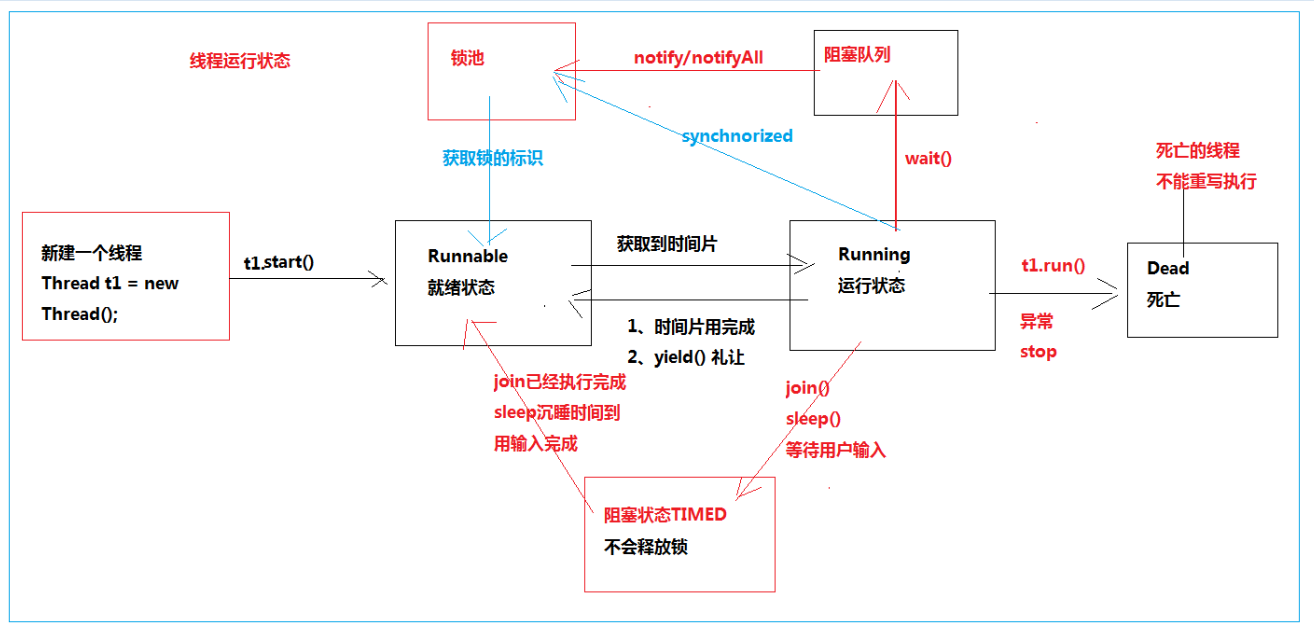线程基础
一、进程和线程区别:
进程就是系统中最小执行单元。
线程是进程中最小执行单元
进程中执行的功能通过线程来实现
多个线程共享一个进程中所有资源(PC寄存器,上下文,本地栈)
单进程单线程-> 一人在一个桌子上面吃饭
单进程多线程-> 多个人在一个桌子上面吃饭
多进程多线程-> 每一个人在各自的桌子上面吃饭
-- 由系统调度器调度
-- 线程运行方式:
程序->创建一个线程->start->runnable
系统调度就行状态的中线程->running
-- java中怎么创建线程
Thread
Runnable

无线程
package com.nothread.demo; public class NoThreadDemo { public static void main(String[] args) { // 默认主线程中的执行顺序是从上而下执行的 MyClass cl = new MyClass(); cl.run1(); cl.run2(); } private static class MyClass { public void run1() { while (true) { System.out.println("第一条通道可以到目的地"); } } public void run2() { while (true) { System.out.println("第二条通道可以到目的地"); } } } }
继承Thread
package com.thread.demo; /** * 使用线程 * * @author Administrator * */ public class TestThreadDemo { public static void main(String[] args) { System.out.println("main thread started"); // 创建2个线程 GameThread game = new GameThread(); VoiceThread voice = new VoiceThread(); // 启动线程 start game.start(); voice.start(); // 停止(太暴力终止过程中会出现数据错误问提) try { game.join(); voice.join(); } catch (InterruptedException e) { e.printStackTrace(); } System.out.println("main thread ended~~"); } /** * 游戏线程类 * @author Administrator * */ private static class GameThread extends Thread { @Override public void run() { for (int i = 0; i <10; i++) { System.out.println("执行打游戏"); } } } /** * 开黑线程类 * @author Administrator * */ private static class VoiceThread extends Thread { @Override public void run() { for (int i = 0; i <10; i++) { System.out.println("执行语言通话"); } } } }
实现Runnable方式
package com.thread.demo; public class TestThreadDemo1 { public static void main(String[] args) { System.out.println(Thread.currentThread().getName()); Thread t1 = new Thread(new MyRunnable(), "AAAA"); Thread t2 = new Thread(new MyRunnable(), "BBBB"); t1.start(); t2.start(); } private static class MyRunnable implements Runnable { @Override public void run() { for (int i = 0; i < 10; i ++) { System.out.println(Thread.currentThread().getName()+"执行Runnable接口"); try { Thread.sleep(2000); } catch (InterruptedException e) { e.printStackTrace(); } System.out.println(Thread.currentThread().getName()+"执行Runnable接口"); } } } }
线程状态
package com.thread.demo; public class ThreadStateDemo { public static void main(String[] args) { StateThread st = new StateThread("AAAA"); st.start(); try { st.join(20000000); } catch (InterruptedException e) { // TODO Auto-generated catch block e.printStackTrace(); } System.out.println("main end~"); } private static class StateThread extends Thread { public StateThread(String name) { super(name); } @Override public void run() { for (int i = 0 ; i < 10; i++) { try { Thread.sleep(2000); } catch (InterruptedException e) { e.printStackTrace(); } System.out.println("执行线程内容"); } } } }
jps
jstck


